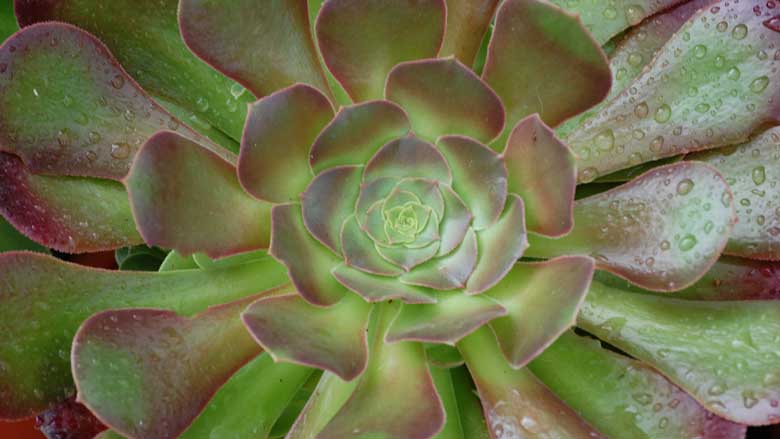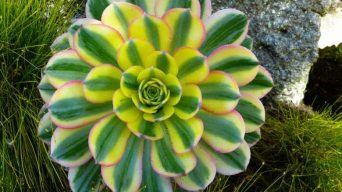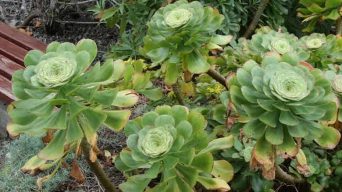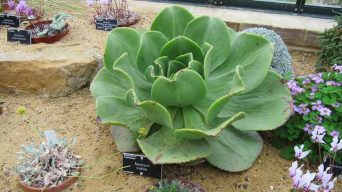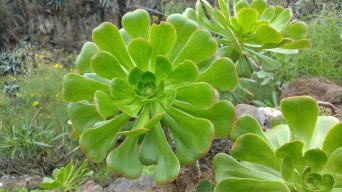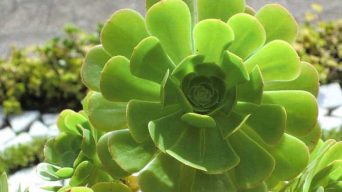Aeonium ‘Blushing Beauty’ succulents are a great addition to your collection of succulents and cacti if you have a green thumb.
The plant has several interesting characteristics, from lovely leaves to colorful flowers.
This article will reveal everything you need to know about caring for your Aeonium ‘Blushing Beauty’ and how to propagate them!
Overview
| Family: | Crassulaceae |
| Genus: | Aeonium |
| Botanical Name: | Aeonium ‘Blushing Beauty’ |
| Synonyms: | Aeonium ‘Blush’ |
| Common Names: | Blushing Aeonium |
| Origin: | Created by Southern California horticulturist Jack Catlin |
| USDA Hardiness Zones: | 9 – 11 |
| Size: | 2-3 ft. tall and wide (60-90 cm) |
| Sun Exposure: | Full sun to partial shade |
| Water Needs: | Water thoroughly but infrequently |
| Soil Type: | Well-draining soil |
| Temperature: | 60˚ to 75˚F (15-24˚C) |
| Humidity Levels: | 40-60% |
The Aeonium ‘Blushing Beauty’ is a hybrid of the Aeonium canariense and the Aeonium arboreum ‘Zwartkop’ succulents.
The Blushing Aeonium, as it is known, produces rosettes of green leaves with red on the edge that can grow up to 2-3 ft. tall and wide (60-90 cm).
The Aeonium plant can flower in the spring. When it does, a delicate pale yellow spike emerges from the center of each rosette with small, star-shaped flowers.
This rosette will flower and die but will produce offsets at its base.
How To Care for Aeonium ‘Blushing Beauty’
Aeonium ‘Blushing Beauty’ care is a process that can be a little difficult to figure out at first.
Below you will find the most important things to consider when caring for the Aeonium ‘Blushing Beauty’.
Sun Exposure & Light Requirements
The Blushing Aeonium requires full sun to partial shade. If Aeoniums are in direct sunlight, they need to be watered more often.
The plant requires at least six hours of sunlight daily.
The Aeonium ‘Blushing Beauty’ naturally prefers very bright indirect light. Still, one could keep them indoors near a window, providing plenty of filtered daylight for about four hours per day.
The Blushing Beauty is one of the hardiest succulents, but too much sun will cause it to turn brown and die, so make sure your plant gets just enough!
Watering Requirements
This particular plant does not require a lot of water, so it should only be watered when the surface has dried out significantly.
If you notice leaves drooping from lack of moisture, give the plant extra time to dry before watering thoroughly.
You can also water a little more often during hot periods.
It will require a surprisingly low amount of water to keep this plant healthy and happy, so don’t overwater it!
Soil Requirements
Aeonium ‘Blushing Beauty’ succulent plant prefers porous soil with a good drainage system.
This is why they are often found in the ground, near a rocky or sandy area, where water can be drained away quickly before it soaks into the surrounding soil and causes root rot.
Soil should be very loose and airy, providing good aeration for ample root growth while holding plenty of moisture without becoming soggy when watered.
A good mix would be a cactus potting mix with a small amount of perlite. This will ensure adequate drainage while retaining water for the succulent plant roots’ uptake.
Temperature and Humidity
Temperature and humidity levels are crucial aspects of succulent plant care.
The Aeonium ‘Blushing Beauty’ typically prefers a slightly warmer temperature.
Between 60-75 degrees Fahrenheit is optimal for this succulent plant, so it’s best to ensure that the surrounding air stays at these temperatures when you place your Aeonium in its location.
If a plant is exposed to a sudden change in temperature, it may result in leaf loss.
The humidity level should be between 40-60% for this succulent. This will prevent the leaves from drying out and help avoid spider mites that can attach themselves to the plants.
A lower humidity percentage would work better if you constantly water your Aeonium ‘Blushing Beauty’. Excess water on top of wet soil or moss could cause mold growth and rot on a plant’s roots.
However, if too low of a percentage causes dryness, then you’ll want higher levels than before (between 60%-75%).
Fertilizing
Aeonium ‘Blushing Beauty’ doesn’t need to be fertilized often.
In a well-draining succulent potting mix, fertilize once a year during the growing season (spring) with a general fertilizer diluted to ½ strength and then water thoroughly.
Potting
When potting your Aeonium ‘Blushing Beauty’, you must use a pot with a drainage hole at the bottom.
This will allow excess water to flow out of your container and not stagnate lower in the soil while creating a pooling effect. This could lead to root rot if too much water accumulates for too long.
The container should be appropriate so it is not overcrowded with roots when propagating new succulents from cuttings or stem pieces.
The potting mix shouldn’t come more than two-thirds up the sides of the container because these plants like plenty of air circulation around their leaves and stems.
Pruning
The Aeonium ‘Blushing Beauty’ succulent plant does not need much pruning. Still, removing any dead leaves and flowers as they appear is a good idea.
- Remove all the stems that are taller than a foot from the ground.
- Cut back some branches by a third if you want to cut them back more severely.
- The Aeonium can be cut back by a third every year to keep the plant more compact.
- The Aeonium ‘Blushing Beauty’ is a slow grower, so you usually don’t need to prune it more than once a year.
Pests and Diseases
A few pests can attack Aeonium ‘Blushing Beauty’, including mealybugs, mites, and scale.
To get rid of these pests, use a diluted dishwashing soap spray or neem oil with a cotton swab to apply directly onto the pest.
Aeoniums are very hardy succulents but can still get a few diseases.
The most common disease is rot or rotting, which looks a little like a dark brown water spot on your plant’s leaves.
You’ll know if you have a rotting problem because the whole leaf will eventually turn black and die off from that one point of infection. This makes them easy to identify as a possible cause of plant health problems.
To treat this, use neem oil mixed in distilled water every two weeks until all symptoms disappear. It would be best to cut off dead leaves so any decaying material doesn’t spread to healthy parts of the plant body.
How to Care for Aeonium ‘Blushing Beauty’ in Winter
Like many succulents, Blushing Aeoniums need very little care in the winter.
As long as they are given a warm and dry place (above 65 degrees), they will be happy.
During this time, their water requirements drop once every two weeks.
If you have a low-light area where your plants can stay outdoors for part of the year without getting too cold at night, then pot them up on a large tray with rocks heated by an incandescent bulb placed over it.
Don’t overwater during the winter months because stagnant moisture may cause rot to develop under warmer conditions indoors. This could lead to a fungal attack that will weaken and kill the plant.
How To Propagate Aeonium ‘Blushing Beauty’
Stem cuttings and leaves can propagate the Blushing Aeonium succulent.
Stem Cuttings
When Aeoniums are grown from cuttings, it is essential to note that a general rule of thumb for a healthy succulent cutting: thicker is better. Stem cuttings should be at least three inches long and have a diameter larger than a pencil lead.
- Cut a succulent stem a few inches from the ground.
- The end of a cut should be a clean, straight line.
- Allow the cuttings to callous for a few days before planting.
- Plant cuttings in a succulent potting mix that is well-draining.
- Water cuttings gently.
- Keep the pot in a warm, sunny location.
- When roots start to form, it is time to transplant them into a larger pot.
- Plant the cuttings in a succulent potting mix that has more organic material, such as sand or leaf litter.
- Water lightly for a month before returning to the regular watering schedule.
Leaf Cuttings
Aeonium ‘Blushing Beauty’ leaves can be propagated by a straightforward process.
- Remove a leaf from a stem.
- Allow the cut to callous for a few days before planting it in a succulent potting mix that is well-draining.
- Water gently and keep in a warm, sunny location until roots start forming.
- Plant a leaf in a succulent potting mix with more organic material, such as sand or leaf litter.
- Water lightly for a month before returning to the regular watering schedule.
Is the Aeonium ‘Blushing Beauty’ Toxic?
The Aeonium ‘Blushing Beauty’ plant is not toxic to humans or animals.
It is always advisable to wash one’s hands before and after handling this plant and put on gardening gloves.
Final Thoughts
The Aeonium ‘Blushing Beauty’ succulent is an excellent plant for beginners because it requires very little care.
If you’re looking for a low-maintenance houseplant that looks great in any decor, then look no further than the Aeonium ‘Blushing Beauty’ succulent!
The simple care requirements make this a perfect choice for an apartment dweller who may need more time to care for their plants.
Aeoniums are tough as nails, and there is little chance of them dying if neglected. But with a bit of love and attention, they’ll flourish just like any other houseplant.

